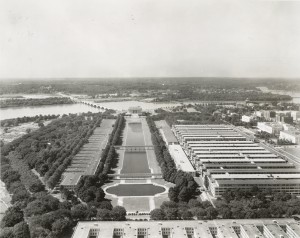The first primary source I found was a picture taken from the Washington Monument. This picture shows the area of reclaimed land west of the monument where the reflecting pool and the Lincoln Memorial are located. This land wasn’t created until the late 19th into the 20th century. Corroborating with other sources shows that pictures and maps of this area created before the late 1800‘s look drastically different. Other pictures of the area also show that the two walkways that traverse the pool in this picture no longer exist. The buildings located on either side of the reflecting pool in this picture are also no longer in this area. The photo was taken in 1942, so using contextualization, it might be possible that the buildings were involved with the United States’ war effort in World War II.
The second primary source I found was an image of a war bond ad located in the Washington Herald. It was printed in October of 1917, towards the end of World War I when supplies and money were still necessary. It shows the war effort that was going on at home and that many different people were involved in it, especially in the District of Columbia. In this ad, the space was paid for by an inn and the Banker’s Association of The District of Columbia. In World War I and World War II, these advertisements for bonds were quite common. Looking at other ads show that most of them appeal to an American’s sense of patriotism and the idea that civilian involvement will help the soldiers overseas. Putting advertisements for bonds like this one in the Washington Herald guaranteed that a sizable number of people would see them, as the Herald was a very popular paper during the early 20th century.
I found that the photo was easier to work with. I tend to be more of a visual person, so looking at a picture and working with the information that it provided wasn’t as difficult. There are also many other pictures of the same thing available, which makes it easier to corroborate information with other sources.


One Response to “Primary Sources”
Sarah,
I think you’ve done a pretty good job analyzing these two primary sources. Interestingly, I think you’ve done a better, more provocative job of analyzing the advertisement. I think this comes down to close reading. You’ve done a very good job of reading between the lines to capture the nationalist message the advertisement is sending. In the case of the image, you’ve corroborated well, but you haven’t really contextualized so much as speculated. Historians like hard facts; you had a hunch – investigate it. This will help with the close reading.
Keep up the good work.
– Claire